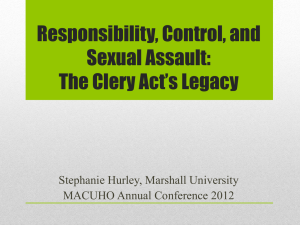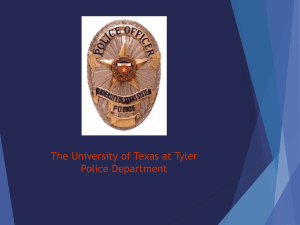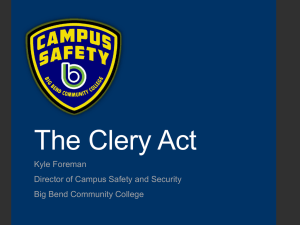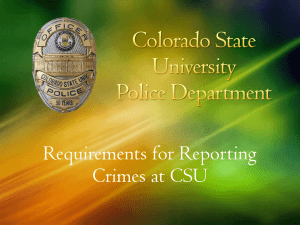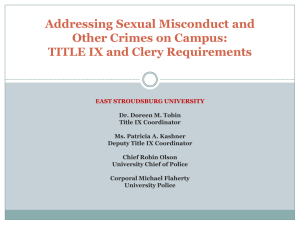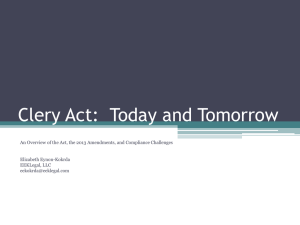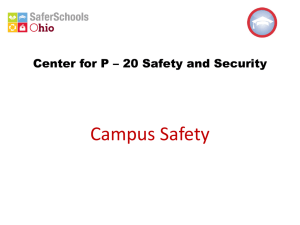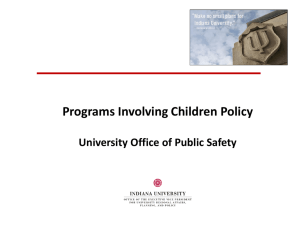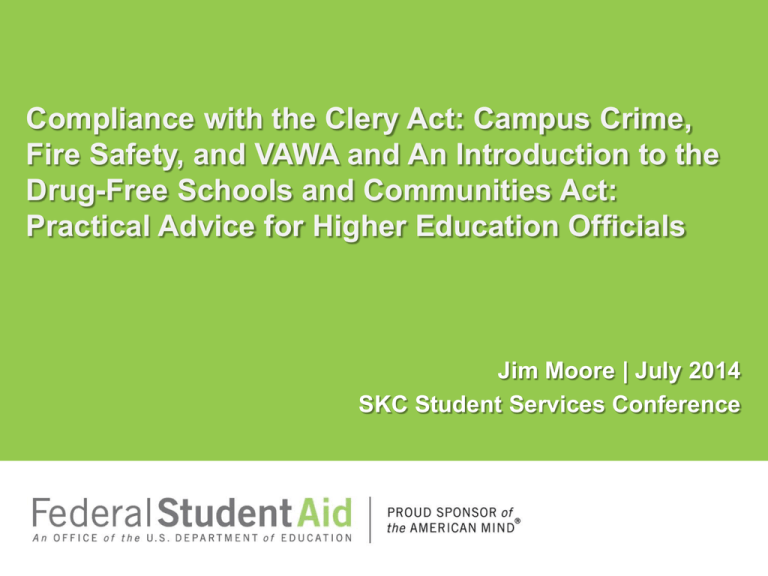
Compliance with the Clery Act: Campus Crime,
Fire Safety, and VAWA and An Introduction to the
Drug-Free Schools and Communities Act:
Practical Advice for Higher Education Officials
Jim Moore | July 2014
SKC Student Services Conference
Disclaimer
This presentation provides general information about
the Clery Act and the Drug-Free Schools and
Communities Act and does not represent a complete
recitation of the applicable law or ED/FSA policies in
this area and is for discussion purposes only. This
presentation must not be used for any other purpose.
Actual compliance determinations must be made after
a careful analysis of specific facts on a case-by-case
basis.
Agenda
Background
•
Clery Act Basics
• Violence Against Women Reauthorization Act (VAWA)
– “10 Things That You Need To Know About VAWA”
• Drug-Free Schools and Communities Act
• (Quick) Note on Related Issues: FERPA; Title IX
• Clery/Part 86 Program Review Overview
• Resources – Resource Sheet
• Questions
3
Background
Campus safety requirements in the HEA
•
•
•
•
•
•
•
4
The Crime Awareness and Campus Security Act of 1990
1992 Amendments first added policies on sex offenses
1998 Amendments expanded the requirements and renamed
the law - Jeanne Clery Disclosure of Campus Security Policy
and Campus Crime Statistics Act (Clery Act)
HEOA in 2008 again expanded the requirements
“Campus SaVE” provisions of the Violence Against Women
Act (VAWA) will be added in October 2014
Legislation: 20 USC § 1092(f)
Regulations: 34 C.F.R. §§ 668.14, 668.41, 668.46, and 668.49
Background
Federal Student Aid (FSA) monitors & enforces the Clery
Act & conducts campus crime program reviews
•
Possible consequences of review findings:
•
•
Fines - up to $35,000 per offense (recently increased)
Limitation, suspension, or termination of the eligibility for student
financial aid programs; denial of recertification or revocation of a
provisional Program Participation Agreement (PPA)
Special Note:
The Secretary “shall impose” a civil penalty for any Clery Act
violation that rises to the level of a “significant misrepresentation.”
5
Clery Basics
The Clery Act requires all schools to:
•
•
•
•
6
Collect, classify, and count crime reports and crime statistics
Publish and actively distribute an annual security report that
contains all statistical and policy disclosures – must be a
single, comprehensive report
Submit crime statistics to ED
Issue Timely Warnings and Emergency Notifications
Clery Basics
Requirement: Collect, classify, and count crime reports
and crime statistics
•
7
Currently includes three broad categories of crime (VAWA
added a 4th)
Clery Basics
Requirement: Collect, classify, and count crime reports
and crime statistics
•
Schools disclose reported offenses, regardless of whether
someone is found guilty
•
•
•
•
8
“Reported” = brought to the attention of a campus security authority or local
law enforcement personnel
Crimes may be reported anonymously or not, but PII must not
be included in your crime statistics
Count both attempted and completed crimes
Make a reasonable, good faith effort to obtain Clery crime
statistics from local law enforcement agencies with jurisdiction
over all parts of your Clery geography
Clery Basics
Requirement: Collect, classify, and count crime reports
and crime statistics
•
Hate crimes are motivated by the offender’s category of bias
•
•
•
•
•
•
9
Race
Gender
Religion
Sexual orientation
•
•
•
•
Ethnicity/national origin
Disability
Perceived gender**
Gender identity**
**To be added to the regs (per the Matthew Shephard Act, 2009)
Arrests and referrals for disciplinary action are based on
violations of weapons, drug, and liquor laws, not of institution
policies
Clery Basics
Requirement: Publish and distribute an ASR
•
•
•
Must publish the annual security report by October 1 each year
Report must be contained within a single document
Report must include:
3 calendar year’s of campus crime statistics
• All required current campus safety and security policies and procedures
•
10
Clery Basics
Requirement: Publish and distribute annual security
report
•
Must distribute the annual security report to all enrolled
students and current employees
•
Directly by mail, hand delivery, or email or
• By posting on an Internet or intranet site that is reasonably accessible to
current students and employees*
•
11
*If you post the annual security report online, you must
distribute a notice by October 1 with statement of report’s
availability, exact URL, a description of contents, and
statement that paper copy is available upon request
Clery Basics
Requirement: Publish and distribute annual security
report
•
Must actively notify prospective students and employees
about the availability of the ASR. The notice must include a
description of the report’s contents and explain how to obtain
a paper copy
•
Must provide a copy of the ASR upon request
• If posted on an internet site, notice must also include exact URL where ASR
is posted
•
12
For prospective students and employees, information may not
be posted on an intranet site
Clery Basics
Requirement: Submit crime statistics to ED
•
•
•
•
13
Institutions report campus crime statistics for the 3 mostrecent calendar years
Must match the statistical disclosures that were published in
the annual security report
Deadline for completing the web-based data collection is
specified by the Secretary each year – typically mid-October
Collected data are posted on OPE’s Data Analysis Cutting Tool
(linked to College Navigator) for public use
Clery Basics
Additional requirements:
•
Institutions with campus police or security departments must
additionally maintain a daily crime log
•
Institutions with on-campus student housing facilities must
additionally:
•
Disclose missing student notification procedures that pertain to students
residing in those facilities
• Comply with fire safety requirements
14
Clery Basics
Requirement: Daily Crime Log
•
Log is a daily record of criminal and alleged criminal incidents
reported to the campus police or security department
•
All crimes on Clery geography or within patrol jurisdiction of the campus
police/security department
• Not just Clery Act crimes
• Records nature, date the crime was reported, time, date, general location,
and disposition (if known) of each crime
15
Clery Basics
Requirement: Daily Crime Log
•
Log must be available
•
Must be accessible on-site (written or electronic)
• Available upon request for public inspection during business hours (most
recent 60 days available immediately; older records available within 2
business days)
• Must be available without payment or written request
•
Log must be maintained
•
Must make additions or updates to an entry within two business days
• Update disposition up to 60 days from when crime was entered in the log
• Schools must archive log for seven years
16
Clery Basics
Requirement: Fire Safety Policies and Statistics
•
3 primary compliance areas:
•
Annual fire safety report
• Submit fire statistics to ED
• Fire log
17
Clery Basics
Requirement: Publish an annual fire safety report
•
•
Must publish annual fire safety report by October 1 each year
Report must include:
•
Fire statistics
• Current fire safety policies and procedures
• must be a single, comprehensive report
•
Annual fire safety report and annual security report
•
May be published separately or together
• If published separately, specify how to access the other report in each one
18
Clery Basics
Requirement: Submit fire statistics to ED
•
Must annually submit 3 years’ worth of statistics to the
Department
•
Collected in the same web-based collection tool as the campus crime
statistics
• Includes statistics for each on-campus student housing facility – if
questions arise about ownership or whether a housing unit is actually oncampus, please consult with the Clery Division – clery@ed.gov
•
19
Statistics include:
•
Number and cause of each fire
•
Number of persons with injuries related to a fire that resulted in treatment at
a medical facility
•
Number of deaths related to a fire
•
Value of property damage
Clery Basics
Requirement: Fire log
•
Fire log is a record of any fire that occurs in an on-campus
student housing facility
•
Records nature, date the crime was reported, time, date, nature, and general
location of each fire
• Must be written and easily understood
•
20
Annual report to the campus community on fires recorded in
the log
Clery Basics
Requirement: Fire log
•
Log must be available
•
Must be accessible on-site (written or electronic)
• Available upon request for public inspection during business hours (most
recent 60 days available immediately; older records available within 2
business days)
• Must be available without payment or written request
•
Log must be maintained
•
Must make additions or updates to an entry within two business days
• Update disposition up to 60 days from when crime was entered in the log
• Schools must archive log for seven years
•
The fire log may be combined with the daily crime log
•
Label it well so users know it is both a crime and fire log
• Ensure that it contains the required elements for both logs
21
VAWA
Violence Against Women Reauthorization Act of 2013
(VAWA)(Pub. Law 113-4)
•
•
22
Enacted March 7th, 2013
Amended the Clery Act
•
Requires expanded reporting for incidents of sexual assault,
dating violence, domestic violence, and stalking institutions
that are reported to campus security authorities or local police
agencies
•
Requires institutions to include certain policies procedures,
and information about certain training programs in the ASR
VAWA
New Programmatic and Training Requirements include:
• Awareness
• Primary Prevention
• Bystander Intervention
• Specialized Training for Adjudication Officials
Regulatory changes affect ASRs and crime statistics
reported to ED beginning Fall 2014
Until final regulations are issued, institutions must
make a good faith effort to comply with the statute
23
VAWA
Implementation Timeline
• Early 2014 – Negotiated Rulemaking Committee
meetings
January 13-14 – First round of negotiations
• February 24-25 – Second round of negotiations
• March 31–April 1 – Third round of negotiations – Consensus Reached!!!
•
October 2014 – Institutions complete annual security reports
and report to ED using good faith effort
With the Master Calendar in mind, The GOAL for publishing final
regulations is November 1, 2014
•
•
•
24
July 2015 – Final regulations become effective
October 2015 – Institutions complete annual security reports
and report statistics to ED under final regulations
Drug-Free Schools & Communities Act
Implemented by 34 CFR Part 86
• Requires institutions to certify that they have
developed and implemented a drug and alcohol
abuse education and prevention program (DAAPP) –
completed through the PPA
•
•
•
25
The program must be designed to prevent the unlawful
possession, use, and distribution of drugs and alcohol on
campus and at recognized events and activities
As part of the program, institutions must distribute certain
information to students and employees annually
Institutions must do a biennial review of the program
Drug-Free Schools & Communities Act
Annual disclosure
•
•
Must share information with current students and employees
34 CFR § 86.100 outlines the information that must be
included:
•
•
•
•
•
26
Standards of conduct prohibiting the possession, use, and distribution of
drugs and alcohol
Possible sanctions for violations of Federal, state, and local drug and
alcohol laws as well as sanctions for violation of institutional policies
Health risks associated with the use of drugs and alcohol
Information on counseling, rehabilitation, and treatment programs
A clear statement that the school will impose sanctions on students and
employees who violate drug and alcohol laws, ordinances, and/or
institutional policies
Drug-Free Schools & Communities Act
Biennial Review
•
Objectives are:
•
To determine the effectiveness of your drug and alcohol abuse prevention
program
• To ensure consistent enforcement of applicable laws, ordinances, and
institutional policies against violators
•
The biennial review report and supporting documents must be
maintained by the school and made available to the
Department upon request
Special Note* The DFSCA requirements are
stackable/cumulative i.e. if an institution fails to develop and
implement a substantive DAAPP, the institution CANNOT
comply with the other requirements
27
How You Can Help!
Make sure that your school has an ASR
• Is it accurate and complete?
• Was it distributed properly?
Review your school’s campus security policies
• Do the policies pass the “smell test?”
• Use what you know about ED’s standards for policy
development
Take a look at your school’s crime log
• Does your school have one?
• Is it accessible to the public?
Best Practices
•
Appoint and empower a Clery Act Compliance Officer
•
Develop an understanding of “Clery Geography”
•
Identify and train “Campus Security Authorities”
•
Specifically inform students and employees about how to report
crimes and emergencies
•
Check crime statistics for similar schools using the “Campus
Safety and Security Data Analysis Cutting Tool”
QUESTIONS?
Jim Moore
Clery Act Compliance Division
james.moore@ed.gov
Keith Ninemire
Clery Act Compliance Division
keith.ninemire@ed.gov
30

